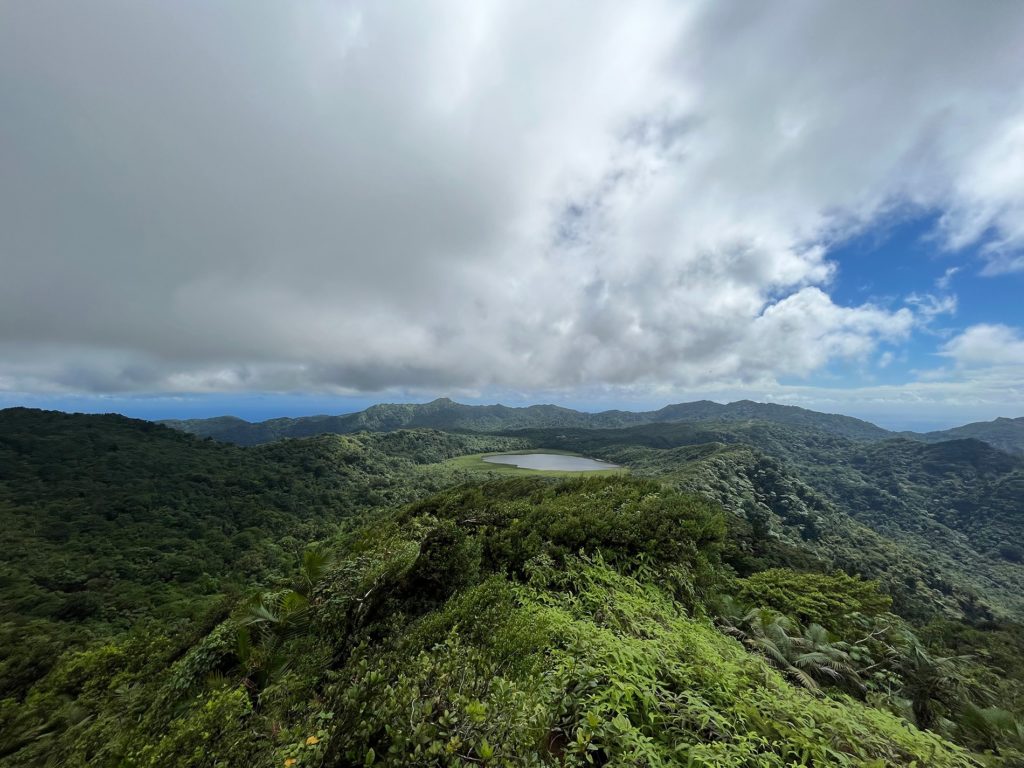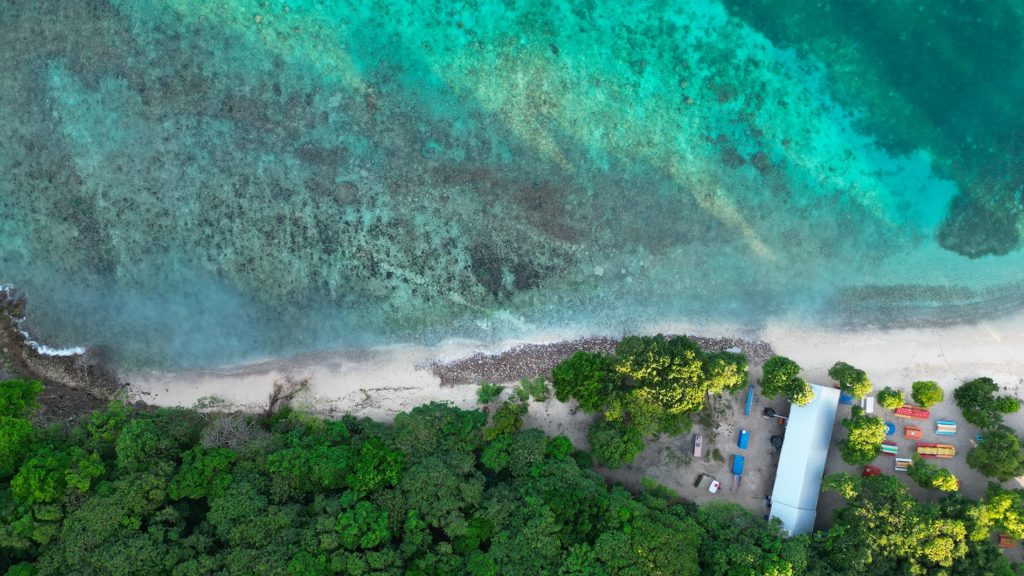Text: Quentin Mayerat
Photos: Joseph Favre
A paradise for winter yachting, the Lesser Antilles are full of possibilities. Our mount, a Pogo 12.50, rented from Open Sail, will enable us to point our bow wherever we please when we leave Martinique. The weather window is attractive, with a steady trade wind. We’ll be covering some fine distances at an average of 10 knots. Heading south!

The vacations are shaping up nicely, and we’re spoilt for choice. The Lesser Antilles offer an almost limitless playground, whether you’re sailing north to Guadeloupe or south through the myriad islands of the Grenadines. Our adventure begins in Martinique, on the pontoons of Le Marin. It’s here that many of the sailors at the end of a transatlantic race and a few hardened racers fresh from their Jacques Vabre run aground. A few of the latest generation Class40s are here, on stand-by before their return to the Old Continent. Alongside them, our 12.50, which is nothing other than a mellowed-out Class40, remains in the theme. However, our boat offers far more comfort than the stripped-down machines of the ocean racers. Our averages will reflect this subtle compromise between habitability and performance.
On the eve of casting off, the crew draws up their navigation plan over a de rigueur Ti’punch. “Why not go down to the island of Grenada,” suggests one of the crew. “And what about going down there, but in one go, to get a taste of the sea spray?” adds the captain. The decision’s made. The next day, we’ll be setting off in a steady trade wind, for our first 180-mile adventure along the Caribbean arc.
Windward or leeward?
Fetch fresh air from the island winds, or risk infernal devents? Such is the eternal dilemma of Caribbean cruising. We were eager to exploit our splendid mount, so our enthusiasm guided us towards the sportiest route – meaning the least comfortable. Synonymous with downwind sailing in a transatlantic race, the trade winds are more likely to be on the beam in the Lesser Antilles. Depending on the route and wind angle, upwind sailing is commonplace! This was the case from our very first miles in the Saint Lucia Channel. Watch out for the current – it’s often stronger than it looks. Keeping as close to the wind as possible from the outset can be a lifesaver. Northern Saint Lucia is only 30 km from the southern tip of Martinique. If you don’t plan ahead, you can quickly be caught sailing too close to the coast.
With the swell and wind picking up as soon as night falls, our crew will be treated to an express mooring. Our boat, used to covering thousands of miles every year in transatlantic races, is making good progress. With one reef in the mainsail, she cuts through the waves with confidence in 25 knots of wind. When we’re finally able to leave St. Lucia to starboard, the wind picks up and the swell gradually moves in the right direction. The Pogo accelerates and offers us plenty of wild surfing. In the dark of night, the sensation of speed is multiplied tenfold, and our senses are awakened.
On our chart, the islands scroll by. We swallow up the miles and effortlessly overtake the pebbles with their familiar names, often mentioned by yachtsmen: Saint-Vincent, Bequia, Moustique, and so on. Showers of shooting stars accompany our vessel towards its goal. The first light completes this dreamlike picture. The contemplative faces of the crew on deck speak volumes. In the distance, the fresh colors of dawn reveal the incredible beauty of the scenery. This chain of underwater mountains known as the archipelago continues to unfold: Mayreau, Union, Carriacou, Ronde Island. With the wind still easing a little, the gennaker will be out until we reach Saint-Georges, the capital of Grenada, the southernmost point of our journey.
Rasta Grenada
Grenada, or the island of spices. Cloves, turmeric and, above all, the highly prized nutmeg, the driving force behind the fierce colonial expeditions, proliferate here. Today, just over 100,000 souls inhabit this rollercoaster-like territory, dented by its many volcanoes. Independent in 1974, Grenada experienced a communist revolution in 1979, before being brought back into line by the American policeman in 1983 during an airborne intervention. The prevailing Reagan doctrine, seeking by all means to counter Moscow’s influence, left Grenadians with little choice but to settle for capitalism! Today, superyachts proliferate in the modern marina of Saint-Georges. We’ll opt for an offshore mooring. A practical and economical solution, although the swell tends to make the anchorage a tad rolly.

The island’s towering peaks and lush forests beckon. At the marina, the colorful and well-sounding local cabs crowd around to negotiate day trips. It’s to the tunes of Bob Marley – which will accompany us, wherever we are, throughout our journey – that we set off to climb Mount Qua Qua (pronounced kwakwa), the island’s second highest peak. From its 713-metre peak, the view is breathtaking, and the hike is accessible to all levels. In its national park – known as Grand Etang – keep your eyes peeled for mischievous primates. A few kilometers from the start of our short hike, another discovery awaits us. We re-enter the jungle to reach the Seven Sisters, a succession of magnificent waterfalls that invite you to swim and contemplate, without moderation.
Carriacou: Caribbean ambience
After two days spent exploring the surroundings of Saint-Georges, it’s with a touch of regret that we jettison our corpse-mort. The lively streets, the market, the enchanting nature, the friendly people and their music, give us a glimpse of the thousand possibilities of a stay on the main island of the state of Grenada. We’re off again, sailing close-hauled towards Carriacou. On the way, be sure to shave – always with care – the many pebbles you’ll come across, which are a marvellous way to navigate. Just before sunset, we set sail for Tyrell Bay, Carriacou’s main anchorage. While the sheer number of units on site can make you dizzy, the perspective from land is quite different. We’re jumping right into the Caribbean stereotype. Sip your drink facing the beach, in one of the many bars lining the bay. Just a few centimetres from the shore, a host of picturesque boats lie at anchor, some of them very old! Here again, the echoes of the King of Reggae can be heard, and evenings can easily be extended to the rhythm of a few musicians in search of an audience.

Tyrell Bay offers excellent shelter and atmosphere, but the treasures of Grenada lie a little further north. We lift anchor for a micro-sail, this time under motor, towards Sandy Island. This coral-fringed spit of sand, some 150 metres long, is 800 metres from Carriacou and offers a Robinson-like anchorage. This tiny turquoise-water setting, dotted with a few coconut palms, is sometimes a victim of crowds. We recommend mooring to a mooring rope to protect the seabed, which offers extraordinary biodiversity. Protected from the swell, but hardly from the wind, Sandy Island is also an exceptional spot for anyone with a kite, wing or windsurfer on board.



Border Islands
Our ascent northwards continues. Soon, it will be time to cover Saint-Vincent and the Grenadines. We point our bow northeast of Carriacou, where two islets face each other: Petite Martinique and Petit Saint-Vincent. These two sisters, separated by barely 500 meters, have very little to do with each other. Petite Martinique is home to 900 inhabitants who lead a peaceful life in harmony with their environment. Petit Saint-Vincent is an entirely private hotel complex. Beware of those like us who land on its beaches with their dinghy. Alert security personnel will quickly block their way. Access is possible, however, on condition that you pay $100 per person per day.
The anchorage on the south coast is one of the most enchanting of our cruise. The two islands form an immense lagoon, bordered to the north-west by the famous Morpion islet, a famous sandbank flanked by a single hut made of coconut leaves. The gigantic coral reef still conceals a thousand treasures. Our excitement is at its peak when we finally come across a harmless reef shark meandering nonchalantly between the cays. After 48 hours, it’s time to head north again and discover the anchorages of Saint-Vincent, more specifically the Tobago Cays. Since our departure from Grenada, their name has been on every yachtsman’s lips. But what is it really?


Beware of forced sales
After a stopover in Union to complete our clearance – a compulsory procedure for entering and leaving a state – we headed for the famous Tobago Cays with the intention of spending two happy days there. This small archipelago of five islands is reputed to boast one of the most beautiful coral reefs in the West Indies. Naturally, boaters flock here, particularly to the Petit Bateau anchorage, the largest in the area. We opt for a buoy at Petit Rameau, located at the intersection of the three main islands. On site, the boat boys, a sort of salesmen doubling as mooring assistants, offer their services and, above all, reserve a table for the evening at one of the many “lobster barbecues” to be found on the beach. The latter can be insistent, so don’t hesitate to let them know respectfully. We opt to buy lobster to cook ourselves on board – a real treat! Last morning in the Grenadines and last fathom. Stingrays and turtles are out in force for this enchanting final swim. With our suitcases full of souvenirs, we set our Pogo 12.50 back to crossing mode. To make sure we don’t die fools, this time we’ll be sailing downwind of the islands. Indeed, the sea is flat, doesn’t heckle us and the devents aren’t as bad as all that. Next time, we’ll go that way!



Practical info
When to go?
The Lesser Antilles are at their most beautiful from late November to March. The trade winds are steady and sometimes strong. Watch out for squalls, as unpredictable clouds can sometimes bring stronger-than-average winds.
Where to?
Most flights from Geneva and Zurich transit via Paris with Air France or Air Caraïbes. The journey takes between 12 and 15 hours, depending on the stopover.
Rent with Open Sail
French company Open Sail specializes in chartering yachts designed for ocean crossings. Safety equipment, fittings and sails are adapted to the requirements of such a program. The fleet is generally available at
departure from Martinique in winter, and in the Mediterranean or Atlantic in summer. The RM, TS, Pogo and Neel brands are well represented in the fleet. As of this season, Open Sail is even offering an ORC 57 for charter, but with skippers, given the specific features of this beautiful, hair-raising yacht. More information on open-sail.com.
To organize your customized trip and/or navigation
Maison Fert, info@fert.ch, fert.ch.
Or Voile Évasion, fabienne@voile-evasion.ch, voile-evasion.ch.
Good to know
Make sure you find out where and on which islands clearances are carried out, as they are compulsory on entering and leaving the various states. Waiting times can vary, depending on how busy and organized the offices are. In general, it’s best not to be in too much of a hurry. You’re in paradise!

